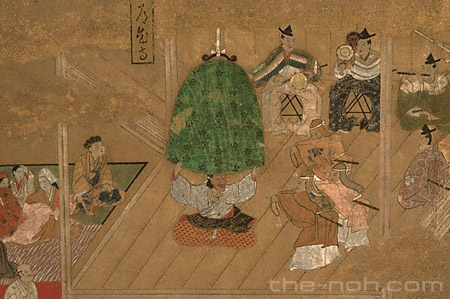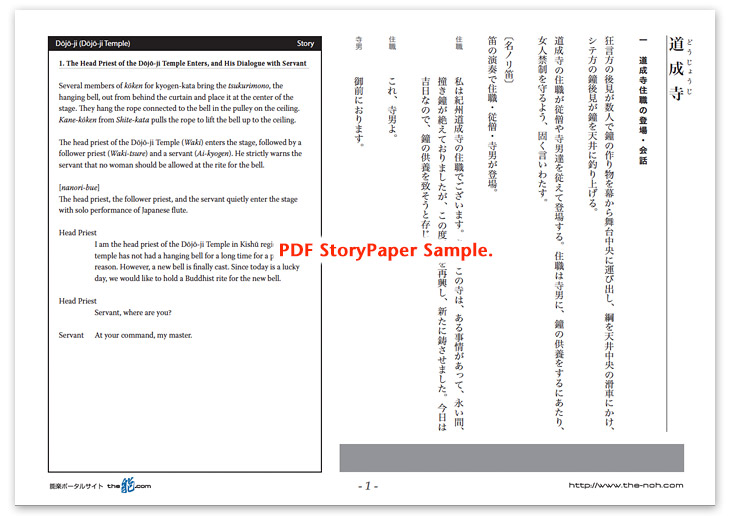
 Dōjō-ji (Dōjō-ji Temple)
Dōjō-ji (Dōjō-ji Temple)

![]()
On a glorious spring day at Dōjō-ji Temple in the Province of Kii, it has been determined that a Buddhist rite for the hanging of a renewed bell will be performed. The head priest of the temple orders the other monks not to allow a woman in for the rite for some particular reason. However, one shirabyōshi (a female dancer who wears a male costume) appears to ask the servant of the temple to allow her to perform a dance for the rite and manages to enter the place where the rite will be held.
The woman steps to a peculiar beat and approaches the hanging bell while dancing. She finally lowers the bell and hides in it.
After hearing the news, the head priest of the Dōjō-ji Temple begins telling a horrible story about the temple. Long time ago, the daughter of the lord of the manor in Manago assumed that she had been betrayed by a certain mountain priest who visited her house every year. She transformed herself into a poisonous snake, chased the priest to the ground, and finally destroyed him as he hid under the bell at Dōjō-ji Temple, by blowing flames of resentment on the bell.
The monks understand that the woman still has her heart set on the man and they pray with all their sacred power and become successful in pulling the hanging bell up. Then, the woman transformed into a monstrous snake appears from inside. After a furious battle, the poisonous snake burns herself with her own flames, which is supposed to burn the bell, and disappears into the deep bed of the Hidaka-gawa River.
![]()
Dōjō-ji is one of the representative works of noh dramas.
One of the highlights of this drama is ranbyōshi, which is performed only by the Shite and a small-drum player for about fifteen minutes. This is a quite difficult part because the two players mark the timing of their performance only by breathing. In this scene, the small hand drum player draws up facing the Shite to create a world keenly focusing on the performance of one other. Besides, this drama is full of special and gorgeous music. The music creates the distinctive attraction of Dōjō-ji.
The climax of this drama is the scene where the Shite jumps underneath the falling bell. This is a quite dangerous performance. Shite can be injured or even killed if he fails in the timing because the bell is so heavy. Kane-kōken, who releases the rope holding the bell, is the second most important roll in this drama after Shite and thereby performed by a skillful, experienced performer.
Shite changes his costume and mask for nochiba in the bell by himself. Dōjō-ji is the only existing noh drama, which lets Shite change his costume alone without the support of kōken. Shite also has to be in charge of some stage effects while he is in the bell, such as to shake the bell in accordance with jiutai and ring nyōbachi (a kind of gong).
Since Dōjō-ji is a story related to the hanging bell of the temple, we might say that the bell plays the main role of the drama; the bell is hung by Kane-kōken first, then Shite enters the dropping bell in the middle of the drama, and finally the bell is pulled back to the bell tower. Generally, noh dramas use the space on the stage horizontally. It is therefore suitable to say that this drama embodies the new challenge of noh since the author directed his attention to the vertical use of space.
STORY PAPER : Dōjō-ji (Dōjō-ji Temple)
Story Paper presents noh chant stories in modern speech, with story outlines, highlights and more using Adobe PDF format, which can print out and zoom in. Print out the pages and take them with you when you see the actual noh performance.

The copyright of Story Paper is held by the Noh.com. Story Paper is for individual use only. It is prohibited by the copyright law to distribute or publish printed-out Story Paper pages without prior consent. For more information, check the credit and disclaimer pages.



 [Dōjō-ji (Dōjō-ji Temple) : Story Paper PDF : 527KB
[Dōjō-ji (Dōjō-ji Temple) : Story Paper PDF : 527KB